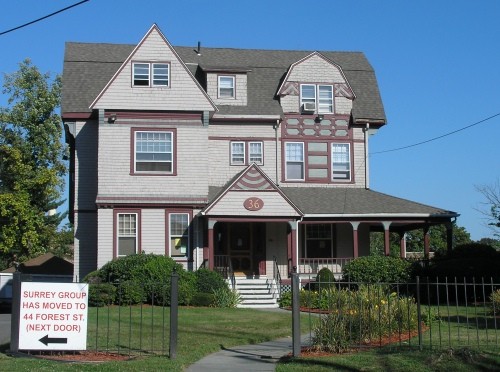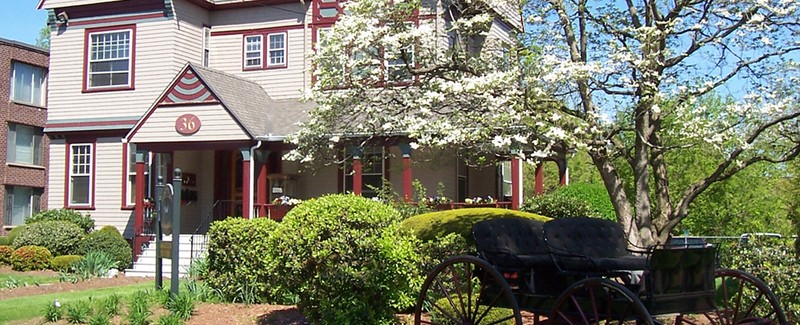Burton House (aka 36 Forest Street House)
Introduction
Text-to-speech Audio
The Burton House, also known as the 36 Forest Street House, is a Shingle-style building in the Queen Anne architectural style, constructed circa 1885 (some claim 1895). It is a two-and-a-half-story house with a brick foundation. According to its National Register of Historic Places (NRHP) nominating form, it is “a substantial Shingle Style house whose classical detailing enhances its urbanity.”
It is historically connected to the Nook Farm literary circle in the 19th Century, which included authors Harriet Beecher Stowe, Mark Twain and others. It is the only 19th Century house surviving on Forest Street, an area that was known for its elegant, spacious houses. (A 19th Century horse-drawn carriage appears on the lawn of the present-day house.)
The house was placed on the National Register of Historic Places in 1983.
Images
An exterior view of the Burton House (36 Forest Street House)

Another exterior view of the Burton House

Backstory and Context
Text-to-speech Audio
An earlier house on this same site burnt down in 1870. The Reverend Nathaniel J. Burton, pastor of the
Fourth Congregational Church, and his wife, Rachel, rented this earlier house for many
years. Some claim that the Burton House is named after
the Rev. Burton, but this is not true. He died in 1887, which was probably before the house was constructed. Rev. Burton’s son, Richard Burton, a literary
critic for the newspaper The Hartford Courant, lived in the house at one point, and it was
after him that the house was named.
In 1853, two men, John Hooker and Francis Gillette, mortgaged Imlay farm from Connecticut Mutual Life Insurance Company. The land included the location of the present property. The two men established Nook Farm, which attracted their friends, including a number of distinguished people: the feminist Isabella Beecher, the novelist Harriet Beecher Stowe, editor Charles Dudley Warner, Samuel Clemens (aka, Mark Twain) and the Hepburn family, one daughter of which, Katherine, became the famous movie actress.
However, Nook Farm was not a financial success. To satisfy the mortgage holder, Connecticut Mutual, instead of a payment of money, Hooker and Gillette deeded to the insurance company the small piece of land on which 36 Forest Street now exists. The insurance company in turn re-sold the land to A. Lyman Williston, who constructed the current house on the property. By 1909, the house and property were owned by an insurance executive named Charles Starkweather – no relation, apparently, to the infamous “thrill killer” of the 1950s.
According to the NRHP nomination form: “Its gambrel roof, overhanging stories and broad veranda are all distinctive characteristics of the Shingle Style.” Each story forms an overhang to the one below, and each overhang is set off with a row of small dentils, so that the wood shingle sheathing never becomes one solid sheet. On the end walls, the overhanging gambrel roof is ornamented with large, scroll brackets with beaded molding. The classical "Queen Anne" style is most apparent in a rectangular oriel projecting at the second story of the north wall.
The house is now a private multifamily dwelling, easily viewed from the street.
In 1853, two men, John Hooker and Francis Gillette, mortgaged Imlay farm from Connecticut Mutual Life Insurance Company. The land included the location of the present property. The two men established Nook Farm, which attracted their friends, including a number of distinguished people: the feminist Isabella Beecher, the novelist Harriet Beecher Stowe, editor Charles Dudley Warner, Samuel Clemens (aka, Mark Twain) and the Hepburn family, one daughter of which, Katherine, became the famous movie actress.
However, Nook Farm was not a financial success. To satisfy the mortgage holder, Connecticut Mutual, instead of a payment of money, Hooker and Gillette deeded to the insurance company the small piece of land on which 36 Forest Street now exists. The insurance company in turn re-sold the land to A. Lyman Williston, who constructed the current house on the property. By 1909, the house and property were owned by an insurance executive named Charles Starkweather – no relation, apparently, to the infamous “thrill killer” of the 1950s.
According to the NRHP nomination form: “Its gambrel roof, overhanging stories and broad veranda are all distinctive characteristics of the Shingle Style.” Each story forms an overhang to the one below, and each overhang is set off with a row of small dentils, so that the wood shingle sheathing never becomes one solid sheet. On the end walls, the overhanging gambrel roof is ornamented with large, scroll brackets with beaded molding. The classical "Queen Anne" style is most apparent in a rectangular oriel projecting at the second story of the north wall.
The house is now a private multifamily dwelling, easily viewed from the street.
Sources
"NRHP Nomination Form: Connecticut Historical Commission." National Park Service. 1983. Access Date: 10/16/16. http://focus.nps.gov/pdfhost/docs/NRHP/Text/83001261.pdf
"Nathaniel Judson Burton." Mark Twain's Neighborhood. Access Date: 10/16/16. http://www.fingerpostproductions.com/nook_farm/pages/burton.html
"Harriet Beecher Stowe’s Nook Farm Neighborhood: a Self-Guided Tour." Harriet Beecher Stowe Center. Access Date: 10/16/16. https://www.harrietbeecherstowecenter.org/pdf/nook_farm_guide.pdf
"36 Forest Street, Hartford (1895)." Historic Buildings of Connecticut. Access Date: 10/16/16. http://historicbuildingsct.com/?p=5232
"House at 36 Forest Street: Historical Place." facebook.com. Access Date: 10/16/16. https://www.facebook.com/pages/House-at-36-Forest-Street/214523251915016?rf=929621740391722
